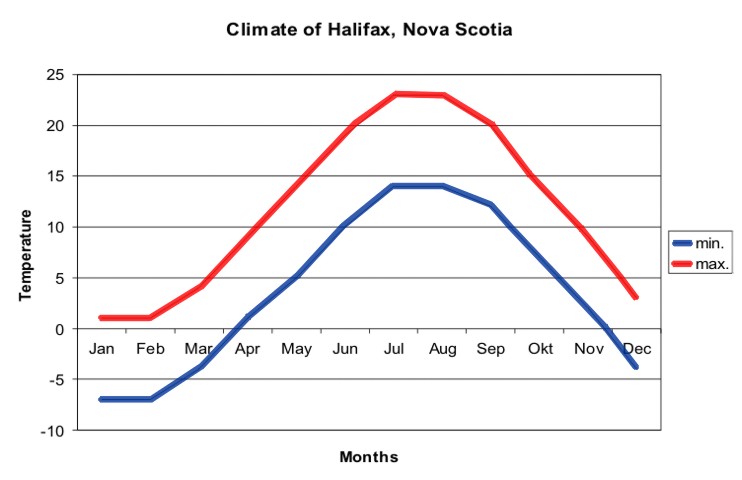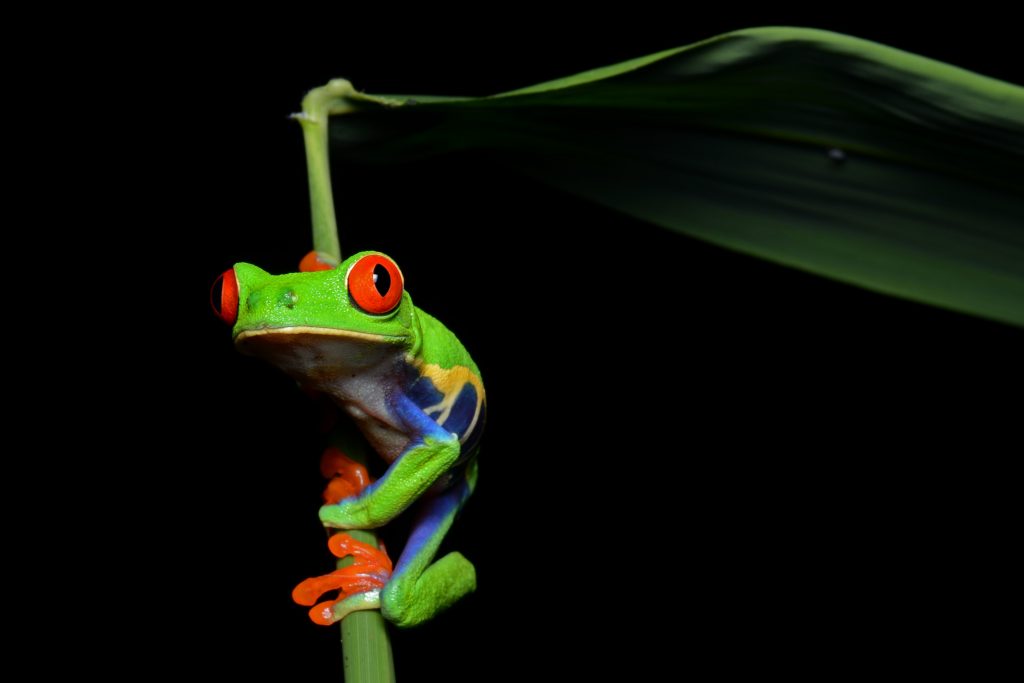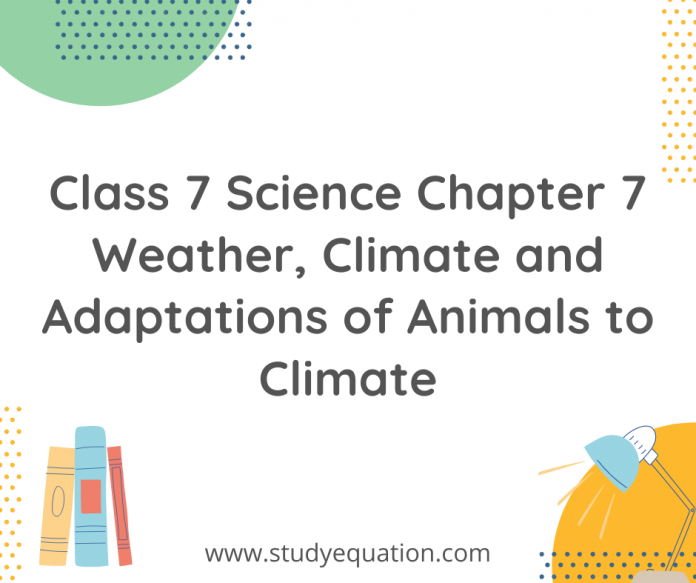Along with NCERT Solutions For Class 7 Science Chapter 7 Weather, Climate and Adaptations of Animals to Climate, we also provide Notes and Lesson Plan for better understanding. Practice your concepts with NCERT Solutions For Class 7 Science Chapter 7 Weather, Climate and Adaptations of Animals to Climate and Extra Questions. Shine among your friends after scoring high in Quiz.
Read more: NCERT Solutions for Class 7 Science Forests Our Lifeline with ppt
Table of Contents
Notes For NCERT Solutions For Class 7 Science Chapter 7 Weather, Climate and Adaptations of Animals to Climate
(Also find NCERT Solutions For Class 7 Science Chapter 7 Weather, Climate and Adaptations of Animals to Climate given below)
Weather
- The weather has a profound effect on our lives.
- Humidity is a measure of the moisture in the air.
- The day-to-day condition of the atmosphere at a place with respect to the temperature, humidity, rainfall, wind speed, etc., is called the weather at that place.
- The temperature, humidity, and other factors are called the elements of the weather.
- The weather is such a complex phenomenon that it can vary over very short periods of time and hence it is not easy to predict.
- There are special thermometers for recording temperatures called maximum and minimum thermometers.
- The maximum temperature of the day occurs generally in the afternoon while the minimum temperature occurs generally in the early morning.
Did you know?

- The weather reports are prepared by the Meteorological Department of the Government. This department collects data on temperature, wind, etc., and makes the weather prediction.
- Rainfall is measured by an instrument called the rain gauge. It is basically a measuring cylinder with a funnel on top to collect rainwater.
Climate
- The average weather pattern taken over a long time is called the climate of the place.
- The records of the weather have been preserved for the past several decades.
- If we find that the temperature at a place is high most of the time, then we say that the climate of that place is hot. If there is also heavy rainfall on most of the days in the same place, then we can say that the climate of that place is hot and wet.
- Mean temperature can be found in two steps.
- First, we find the average of the temperatures recorded during the month.
- Second, we calculate the average of such average temperatures over many years. That gives the mean temperature.
- In the typical desert, the climate is hot and dry. The climate of the north-east is wet.

Climate and Adaptation
- Animals are adapted to survive in the conditions in which they live.
- Features and habits that help animals to adapt to their surroundings are a result of the process of evolution.
The Polar Regions
- The polar regions present an extreme climate. These regions are covered with snow and it is very cold for the most part of the year.
- For six months the sun does not set at the poles while for the other six months the sun does not rise.
- Animals living in the polar regions are many types of fishes, musk oxen, reindeers, foxes, seals, whales, and birds.
- While fish can remain under cold water for long, birds must remain warm to survive.
- They migrate to warmer regions when winter sets in. They come back after the winter is over.

- Polar Bears

- They have white fur so that they are not easily visible in the snowy white background. It protects them from their predators and helps them in catching their prey.
- To protect them from extreme cold, they have two thick layers of fur. They also have a layer of fat under their skin. They are so well-insulated that they have to move slowly and rest often to avoid getting overheated.
- Physical activities on warm days necessitate cooling. So, the polar bear goes swimming.
- Its paws are wide and large, which helps it not only to swim well but also to walk with ease in the snow. It has a strong sense of smell so that it can catch its prey for food.
- It is a good swimmer, while swimming underwater, it can close its nostrils and can remain underwater for long durations.
- Penguin

- It is white and merges well with the white background.
- It also has thick skin and a lot of fat to protect it from cold. They also huddle together to keep themselves warm.
- Penguins are good swimmers. Their bodies are streamlined and their feet have webs, making them good swimmers.
The Tropical Rainforests

- The tropical region has generally a hot climate because of its location around the equator.
- These regions get plenty of rainfall.
- The major types of animals living in the rainforests are monkeys, apes, gorillas, tigers, elephants, leopards, lizards, snakes, birds, and insects.
- Red-eyed frog has developed sticky pads on its feet to help it climb trees on which it lives.

- Monkeys have long tails for grasping branches. Their hands and feet are such that they can easily hold on to the branches. This allows them to live on trees.
- Toucan, which possesses a long, large beak. This helps a toucan to reach the fruits on branches that are otherwise too weak to support its weight.
.

- Many tropical animals have sensitive hearing, sharp eyesight, thick skin, and skin color which helps them to camouflage by blending with the surroundings. This is to protect them from predators for eg, lions and tigers have thick skins and sensitive hearing.

- Lion-tailed Macaque or Beard Ape
- It lives in the rainforests of Western Ghats.
- Its silver-white mane, which surrounds the head from the cheeks down to its chin is its prominent feature.
- It is a good climber and spends a major part of its life on the tree.
- The Beard Ape feeds mainly on fruits. It also eats seeds, young leaves, stems, flowers and buds, and insects under the bark of the trees.
- Since it is able to get sufficient food on the trees, it rarely comes down on the ground.
- Elephant

- It uses its trunk as a nose because of which it has a strong sense of smell. The trunk is also used for picking up food.
- Its tusks are modified teeth. These can tear the bark of trees that the elephant loves to eat.
- So, the elephant is able to handle the competition for food rather well.
- Large ears of the elephant help it to hear even very soft sounds. They also help the elephant to keep cool in the hot and humid climate of the rainforest.
NCERT Solutions For Class 7 Science Chapter 7 Weather, Climate and Adaptations of Animals to Climate
(Also find NCERT Solutions For Class 7 Science Chapter 7 Weather, Climate and Adaptations of Animals to Climate Extra Questions given below)
Q.1. Name the elements that determine the weather of a place.
A) The elements that determine the weather of a place are:
- Temperature
- Humidity
- Rainfall
- Wind-speed
Q.2. When are the maximum and minimum temperatures likely to occur during the day?
A) Maximum temperature is observed during the afternoon whereas the minimum temperature occurs in early morning.
Q. 3. Fill in the blanks
- The average weather taken over a long time is called ………..
- A place receives very little rainfall and the temperature is high throughout the year, the climate of that place will be …….. and ………..
- The two regions of the earth with extreme climatic conditions are ………. and ……….
- The average weather taken over a long time is called the climate of the place
- A place receives very little rainfall and the temperature is high throughout the year, the climate of that place will be hot and dry.
- The two regions of the earth with extreme climatic conditions are polar and tropical regions.
Q. 4. Indicate the type of climate of the following areas:
- Jammu and Kashmir
- Kerala
- Rajasthan
- North-east India
A)
- Hot and wet climate.
- Very hot and wet climate.
- Hot and dry climate.
- Wet Climate.
Q. 5. Which of the two changes frequently, weather or climate?
A) The weather is such a complex phenomenon that it can vary over very short periods of time and hence it is not easy to predict. The average weather pattern taken over a long time is called the climate of the place. Hence, weather changes frequently.
Q. 6. Followings are some of the characteristics of animals:
- Diets heavy on fruits
- White fur
- Need to migrate
- Loud voice
- Sticky pads on feet
- A layer of fat under the skin
- Wide and large paws
- Bright colors
- Strong tails
- The long and large beak
For each characteristic indicate whether it is an adaptation for tropical rainforests or polar regions. Do you think that some of these characteristics can be adapted to both regions?
A)
- Tropical rainforests
- Polar regions
- Polar regions
- Tropical rainforests
- Tropical rainforests
- Polar regions
- Polar regions
- Tropical rainforests
- Tropical rainforests
- Tropical rainforests
No, none of the above characteristics can be adapted for both regions.
Q. 7. The tropical rainforests have a large population of animals. Explain why it is so.
A) As tropical rainforests receive continuous rain and warmth, it supports a large population of animals.
Q. 8. Explain with examples, why we find animals of certain kind living in particular climatic conditions.
A)
- Animals are adapted to survive in the conditions in which they live.
- Features and habits which help them to adapt to their surroundings are the results of evolution.
- This is the reason we find animals of a certain kind of living in particular climatic conditions.
- For example, animals in the polar region are adapted to the extremely cold climate. They have special characteristics, such as white fur, a strong sense of smell, a layer of fat under the skin, wide and large paws for swimming and walking in snow, etc
Q. 9. How do elephants living in the tropical rainforests adapt themselves?
A)
- It uses its trunk as a nose because of which it has a strong sense of smell. The elephant uses the trunk for picking up food.
- Its tusks are modified teeth. These can tear the bark of trees that the elephant loves to eat.
- So, the elephant is able to handle the competition for food rather well.
- Large ears of the elephant help it to hear even very soft sounds. They also help the elephant to keep cool in the hot and humid climate of the rainforest.
Q. 10. Choose the correct option which answers the following question:
A carnivore with stripes on its body moves very fast while catching its prey. You can find it here:
- Polar regions
- Deserts
- Oceans
- Tropical rainforests
A) 4. Tropical rainforests
Q. 11. Which features adapt polar bears to live in extremely cold climate?
- A white fur, fat below the skin, keen sense of smell.
- Thin skin, large eyes, a white fur.
- A long tail, strong claws, white large paws.
- White body, paws for swimming, gills for respiration.
A) 4. A white fur, fat below skin, keen sense of smell.
Q. 12. Which option best describes a tropical region?
- Hot and humid
- Moderate temperature, heavy rainfall
- Cold and humid
- Hot and dry
A) 1. Hot and humid
Practice Last Year Question Papers
Some Frequently Asked Questions
(Here you can find the NCERT Solutions For Class 7 Science Chapter 7 Weather, Climate and Adaptations of Animals to Climate FAQs.)
Q. 1. What is the source of weather?
A) Sun causes all changes in the weather. Energy absorbed and reflected by the earth’s surface, oceans, and the atmosphere play important roles in determining the weather at any place. So, the sun is the primary source of energy that causes changes in the weather.
Q. 2. Why are days shorter in winter as compared to summer?
A) The earth is tilted which causes early sunrise and late sunset during summers, which makes the days longer in summer. On the other hand, late sunrise and early sunset lead to shorter days.
Q. 3. Do fishes and butterflies also migrate like birds?
A) To protect them from the extreme climate, fishes, and butterflies also migrate like birds.
Conclusion: NCERT Solutions For Class 7 Science Chapter 7 Weather, Climate and Adaptations of Animals to Climate
Above written includes NCERT Solutions For Class 7 Science Chapter 7 Weather, Climate and Adaptations of Animals to Climate, detailed Explanation, and Question Answers. Browse our site for various detailed and easy NCERT Solutions and CBSE Notes.





